
- SAP Community
- Products and Technology
- Technology
- Technology Blogs by Members
- Load Data in SAP Using LSMW & File Created By BODS
- Subscribe to RSS Feed
- Mark as New
- Mark as Read
- Bookmark
- Subscribe
- Printer Friendly Page
- Report Inappropriate Content
Legacy System Migration Workbench (LSMW)
Document Purpose
This document provides steps required to load data in SAP using one of the SAP interface LSMW (Legacy System Migration Workbench). This document will be used at the time of proof of concept to load data file generated by BODS into SAP using LSMW interface.
What is LSMW?
The LSMW workbench is an interface that supports data transfer from non-SAP systems (legacy systems) to SAP. LSMW offers number of techniques for migrating data: Direct input, BAPI, IDOC & Batch input recording. The main functions of the LSMW are:
- The tool supports conversion of data (non-SAP to SAP).
- Import data (Legacy data in spreadsheet tables and/or sequential files).
- Convert data (from source format to target format).
- Import data (into the database of the SAP application).
The main objectives are:
- Loading data in SAP using LSM workbench.
- Demonstrate how BODS can used to load data using LSM Workbench.
- Demonstrate actual sample load using BODS job.
Overview:
This document provides systematic approach for the data load in four sections:
- Configuration Required on BODS Side:
- Demonstration Sample Load using BODS Job:
- Configuration Required on SAP Side:
- Checking Processed & Loaded Data in SAP Target:
Each of above sections provide information as in how to configure the specific parameters required to get both BODS & SAP ready to communicate with each other. Screen shots provided for better understanding of the parameters & their configuration
Configuration Required On BODS Side
Following is the required configuration on BODS side.
BODS Batch Job Design
Following job is designed to load data into 'Tab delimited' text file
Extracting Source table
For proof of concept we have taken 'Table' as source in BODS job

Screenshot 1: Source table and data format screen shot
Defining Flat File Structure
- Go to Formats tab and right click on Flat File and select New.
- Enter the Root directory path where the file needs to be generated.
- Enter the File Name as LSMW_INPUT_FF.txt
- Select Type as Tab Delimited.

Screenshot 2: Configuring the Flat File format screen shot
After completion of file format click on "save & close"
BODS job will generate the flat file; it will supply data which is to be loaded in SAP using LSMW.
Note:
No structure is defined in the flat file. As this file acts as target, it can take up the sturture of the immediate previous transformation defined before target by the option "Propogate Column From…"
Building the BODS Job
Drag the table as source and Flat File as target. Place the Query transformation between source and target. Double click on Query transformation. Map required fields from the source table to query, build the required logic to process.

Screenshot 3: BODS JOB Screenshot
Transformations
Query Transformation: Query transformation will map the required columns from source to target file.
Flat File "LSMW_IP_FF.txt": it performing as File Target on the designer to create file in given directory. Click on target LSMW_IP_FF.txt to open the target file editor. Right click on the target & select "Propogate Column From…"

Screenshot 4: Target Flat File Configuration Screen Shot
"Propagate Column to" window will appear by clcking on option"Propagate Column From"
Select required columns from the list of presented. Propogated columns will be shown on right hand side & click on "Propogate & Close".

Screenshot 5: Propagate Column to LSMW_IP_FF.txt Screen Shot
Click on Query Transform to open the Query editor. Review the mapping done.

Screenshot 6: Query Editor Screen Shot
Demonstration Sample Load using BODS Job
Validate the BODS job by clicking validate all button to check on errors if any.
Execute validate Job by right clicking on the Job and click on execute (option)
Running BODS Job
Removed image
Screenshot 7: Running BODS Job Screenshot
Execution Properties Screenshot
Keep default options on this screen & click on ok to execute.

Checking Log for the Job execution
Go to the Log tab, expand the Job, and click on the execution log to check the entries.

Screenshot 8: Log View Screenshot
Statistic view of Job Execution
Click on the statistics button to check processed data statistics.

Screenshot 9: Log file Statistics View
Generated Output file
After successful execution, result of the batch job is generation of flat file in directory path. The generated flat file will be as follows:
Generated Flat File
This flat file is text (.txt) file with all required fields from source, loaded from Batch job.
LSMW flat file data display
The output of flat file data is below
9A | M | CONT | X | BODS-9 test | kg | 01 | NORM |
10A | M | CONT | X | BODS-10 test | kg | 02 | NORM |
11A | M | CONT | X | BODS-11 test | kg | 02 | NORM |
6A | M | CONT | X | test for 100 | kg | 01 | NORM |
7A | M | CONT | X | BODS-7 test for 100 | kg | 02 | NORM |
8A | M | CONT | X | BODS-8 test for 100 | kg | 02 | NORM |
9A | M | CONT | X | BODS-8 test for 100 | kg | 02 | NORM |
Configuration Required On SAP (ECC 6.0)
Following is the configuration required on SAP side.
Upload Flat File using LSMW
Use Legacy System Migration Workbench (LSMW) to upload the flat file created using BODS designer.
Go to TCODE LSMW and Create
- Project
- Subproject
- Object

Screenshot 10: Creation of Legacy System Migration Workbench Screen Shot
Execute the project selection by clicking on execute button
Create Recording
Click on Radio button "Maintain objects Attributes" & Click on execute button
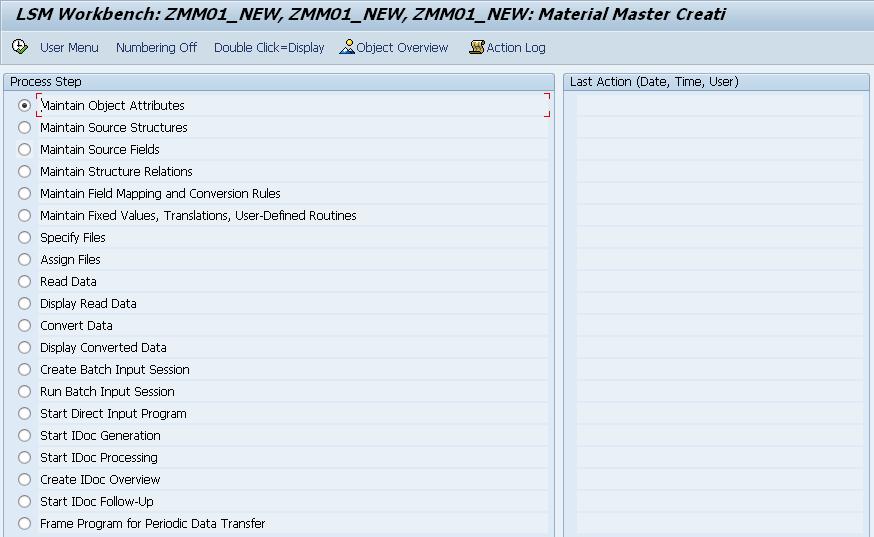
Screenshot 11: "Maintain objects Attributes"
Click on Radio Button "Batch Input Recording" to provide New Recording name as
'ZMM01_NEW' & Click on yellow arrow button to start recording

Screenshot 12: Change Object Attributes Screen Shot
Provide the 'Recording Description' for newly created 'Recording' & Click on continue Button green tik mark

Screenshot 13: Recording Description
Enter Transaction Code (TCODE) MM01 for Recording & Click on continue Button
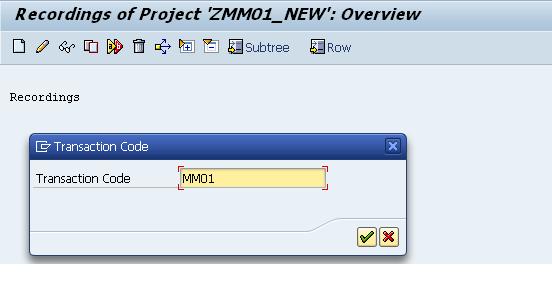
Screenshot 14: Transaction Code Screen Shot
After Successful Recording just go back to recording
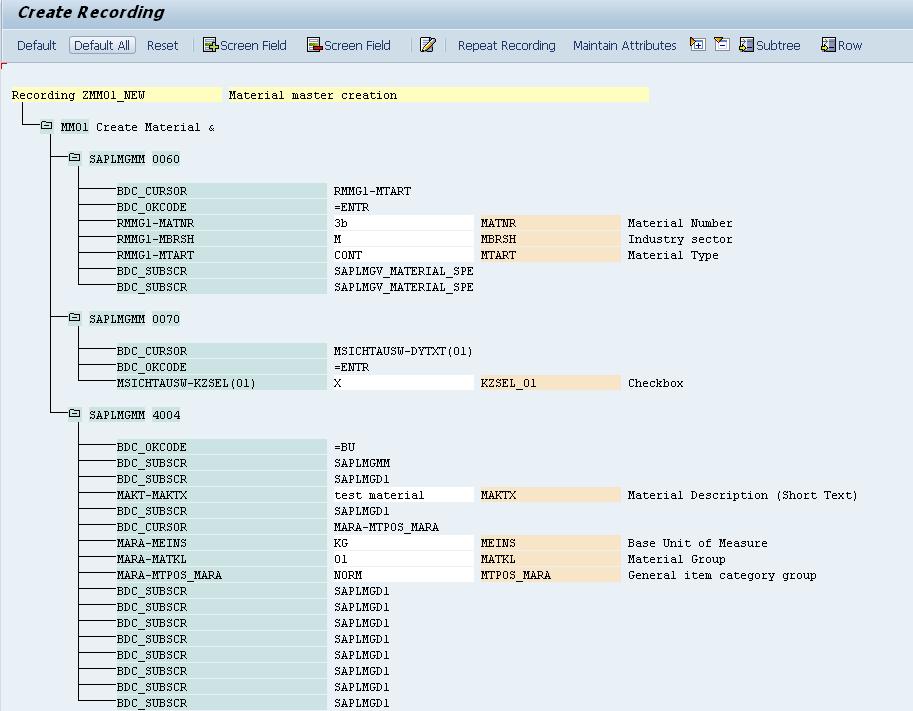
Screenshot 15: Create Recording Screen Shot
Maintain Source Structure
Click on radio button "Maintain Source Structures" & click on execute

Screenshot 16: "Maintain Source Structures" Screen Shot
Create Source Structure for Maintain Source Structure. Save the Structure & go back to main menu of Process Step

Screenshot 17: Source Structure Screen Shot
Maintain Source Fields
Click on radio button "Maintain Source Fields" & click on execute

Screenshot 18: "Maintain Source Fields" Screen Shot
Map all required fields here according to requirement. Click on save & go back to main menu of Process Step
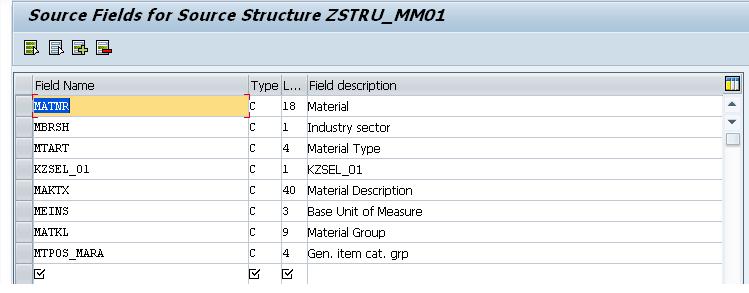
Screenshot 19: Source Fields for Maintain Source Fields Screen Shot
Maintain Structure Relations
Click on radio button "Maintain Source Relations" & click on execute

Screenshot 20: "Maintain Source Relations" Screen Shot
Go to Change, Click on Relationship. Click on save & go back to main menu of Process Step

Screenshot 21: Change Structure Relationships Screen Shot
Maintain Field Mapping and Conversion Rules
Click on Field Mapping and Rule Parent Node to expand. Go to Extras tab, select the option "Auto-Field Mapping"

Screenshot 22: "Auto-Field Mapping Option "Screen Shot
Auto Field Mapping Settings Window
Choose the required settings by clicking on radio buttons for Auto-Field Mapping. Click on Continue

Screenshot 23: Auto Field Mapping Settings
Change Field Mapping and Conversion Rules

Screenshot 24: Click on "Accept Proposal"
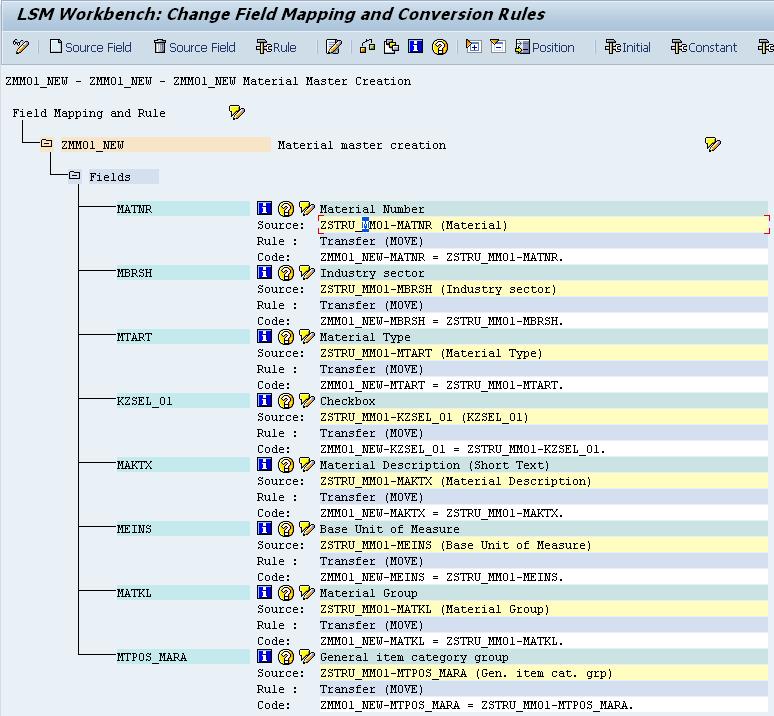
Screenshot 25: Over View of Change Field Mapping and Conversion rules
Maintain Fixed Values, Translations, User-Defined Routines
Click on radio button "Maintain Fixed Values, Translations, User-Defined Routines" & click on execute

Screenshot 26: "Maintain Fixed Values, Translations, User-Defined Routines"
Click on save & go back to main menu of Process Step
Specify Files
Click on radio button "Specify Files" & click on execute

Screenshot 27: "Specify Files" screen

Screenshot 28: File On Front End Screen
Select the file from Presentation Server Directory Path, which have already created from BODS Batch job and click radio button. Choose the File Contents "Data for One Source Structure (table)". Choose the Delimiter "Tabulator". Click on Save & go back to main menu of Process Step
Assign Files
Click on radio button "Assign Files" & click on execute

creenshot 29: "Assign Files" Screen

Screenshot 30: Change Assignment Screen
Click on Change, Click on Assignment, Click on Save & go to back
Read Data
Click on radio button "Read Data" & click on execute

Screenshot 31: "Read Data" Screen

Screenshot 32: Check Records Screen Shot
Go to Check Records to check how many records read & how many records written & go to back
Display Read Data
Click on radio button "Display Read Data" & click on execute

Screenshot 33: "Display Read Data" Screen

Screenshot 34: Display Read Data Screen
Enter required fields and click on continue to check the Display read data
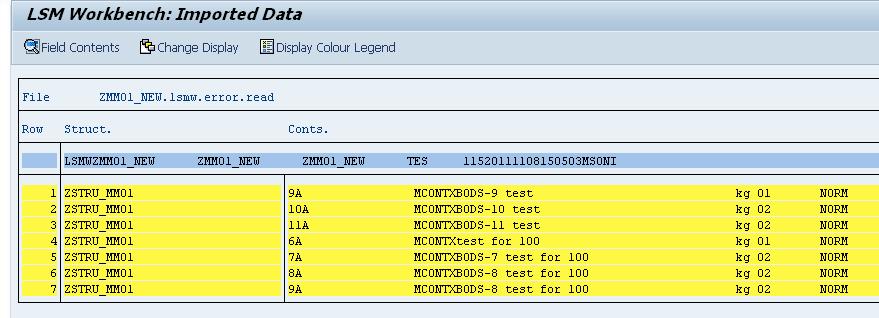
Screenshot 35: Imported Data Screen
Imported Data will display read Records from Read Data & go to back
Convert Data
Click on radio button "Convert Data" & click on execute

Screenshot 36: "Convert Data" Screen

Screenshot 37: Transaction Number Screen
Enter the required transaction number and click on execute

Screenshot 38: Convert Data Display Screen
Data converted for given Transaction Number as displaying in above screen shot & go to back
Display Converted Data
Click on radio button "Displaying Converted Data" & click on execute

Screenshot 39: "Displaying Converted Data" Screen Shot

Screenshot 40: Display Converted Data Screen
Enter the required fields click on Continue to look into display data

Screenshot 41: Convert Data Display
All converted records will display as seen in above screen shot.
Create Batch Input Session
Click on radio button "Create Batch Input Session" & click on execute

Screenshot 42: Create Batch Input Session Screen Shot

Screenshot 43: Generate Batch Input Folder Screen
Enter Name of Batch Input Folder. Check box on Keep batch input folder & click on execute

Screenshot 44: Input Folder Information Screen
After execution, 1Batch input folder created with 3Transactions.
Run Batch Input Session
Click on radio button "Run Batch Input Session" & click on execute

Screenshot 45: Batch Input Session overview
Select the Batch Input Session and click on Process
Checking Processed & Loaded Data in SAP Target
Use T-CODE SE11 and check entries in table MARA to confirm the data loaded

Screenshot 46: SAP LSM Workbench Load Confirmation Screenshot
Records are loaded into table MARA after successful run batch input session.
- SAP Managed Tags:
- SAP Data Services
You must be a registered user to add a comment. If you've already registered, sign in. Otherwise, register and sign in.
-
"automatische backups"
1 -
"regelmäßige sicherung"
1 -
505 Technology Updates 53
1 -
ABAP
14 -
ABAP API
1 -
ABAP CDS Views
2 -
ABAP CDS Views - BW Extraction
1 -
ABAP CDS Views - CDC (Change Data Capture)
1 -
ABAP class
2 -
ABAP Cloud
2 -
ABAP Development
5 -
ABAP in Eclipse
1 -
ABAP Platform Trial
1 -
ABAP Programming
2 -
abap technical
1 -
absl
1 -
access data from SAP Datasphere directly from Snowflake
1 -
Access data from SAP datasphere to Qliksense
1 -
Accrual
1 -
action
1 -
adapter modules
1 -
Addon
1 -
Adobe Document Services
1 -
ADS
1 -
ADS Config
1 -
ADS with ABAP
1 -
ADS with Java
1 -
ADT
2 -
Advance Shipping and Receiving
1 -
Advanced Event Mesh
3 -
AEM
1 -
AI
7 -
AI Launchpad
1 -
AI Projects
1 -
AIML
9 -
Alert in Sap analytical cloud
1 -
Amazon S3
1 -
Analytical Dataset
1 -
Analytical Model
1 -
Analytics
1 -
Analyze Workload Data
1 -
annotations
1 -
API
1 -
API and Integration
3 -
API Call
2 -
Application Architecture
1 -
Application Development
5 -
Application Development for SAP HANA Cloud
3 -
Applications and Business Processes (AP)
1 -
Artificial Intelligence
1 -
Artificial Intelligence (AI)
4 -
Artificial Intelligence (AI) 1 Business Trends 363 Business Trends 8 Digital Transformation with Cloud ERP (DT) 1 Event Information 462 Event Information 15 Expert Insights 114 Expert Insights 76 Life at SAP 418 Life at SAP 1 Product Updates 4
1 -
Artificial Intelligence (AI) blockchain Data & Analytics
1 -
Artificial Intelligence (AI) blockchain Data & Analytics Intelligent Enterprise
1 -
Artificial Intelligence (AI) blockchain Data & Analytics Intelligent Enterprise Oil Gas IoT Exploration Production
1 -
Artificial Intelligence (AI) blockchain Data & Analytics Intelligent Enterprise sustainability responsibility esg social compliance cybersecurity risk
1 -
ASE
1 -
ASR
2 -
ASUG
1 -
Attachments
1 -
Authorisations
1 -
Automating Processes
1 -
Automation
1 -
aws
2 -
Azure
1 -
Azure AI Studio
1 -
B2B Integration
1 -
Backorder Processing
1 -
Backup
1 -
Backup and Recovery
1 -
Backup schedule
1 -
BADI_MATERIAL_CHECK error message
1 -
Bank
1 -
BAS
1 -
basis
2 -
Basis Monitoring & Tcodes with Key notes
2 -
Batch Management
1 -
BDC
1 -
Best Practice
1 -
bitcoin
1 -
Blockchain
3 -
BOP in aATP
1 -
BOP Segments
1 -
BOP Strategies
1 -
BOP Variant
1 -
BPC
1 -
BPC LIVE
1 -
BTP
11 -
BTP Destination
2 -
Business AI
1 -
Business and IT Integration
1 -
Business application stu
1 -
Business Architecture
1 -
Business Communication Services
1 -
Business Continuity
1 -
Business Data Fabric
3 -
Business Partner
12 -
Business Partner Master Data
10 -
Business Technology Platform
2 -
Business Trends
1 -
CA
1 -
calculation view
1 -
CAP
3 -
Capgemini
1 -
CAPM
1 -
Catalyst for Efficiency: Revolutionizing SAP Integration Suite with Artificial Intelligence (AI) and
1 -
CCMS
2 -
CDQ
12 -
CDS
2 -
Cental Finance
1 -
Certificates
1 -
CFL
1 -
Change Management
1 -
chatbot
1 -
chatgpt
3 -
CL_SALV_TABLE
2 -
Class Runner
1 -
Classrunner
1 -
Cloud ALM Monitoring
1 -
Cloud ALM Operations
1 -
cloud connector
1 -
Cloud Extensibility
1 -
Cloud Foundry
3 -
Cloud Integration
6 -
Cloud Platform Integration
2 -
cloudalm
1 -
communication
1 -
Compensation Information Management
1 -
Compensation Management
1 -
Compliance
1 -
Compound Employee API
1 -
Configuration
1 -
Connectors
1 -
Consolidation Extension for SAP Analytics Cloud
1 -
Controller-Service-Repository pattern
1 -
Conversion
1 -
Cosine similarity
1 -
cryptocurrency
1 -
CSI
1 -
ctms
1 -
Custom chatbot
3 -
Custom Destination Service
1 -
custom fields
1 -
Customer Experience
1 -
Customer Journey
1 -
Customizing
1 -
Cyber Security
2 -
Data
1 -
Data & Analytics
1 -
Data Aging
1 -
Data Analytics
2 -
Data and Analytics (DA)
1 -
Data Archiving
1 -
Data Back-up
1 -
Data Governance
5 -
Data Integration
2 -
Data Quality
12 -
Data Quality Management
12 -
Data Synchronization
1 -
data transfer
1 -
Data Unleashed
1 -
Data Value
8 -
database tables
1 -
Datasphere
2 -
datenbanksicherung
1 -
dba cockpit
1 -
dbacockpit
1 -
Debugging
2 -
Delimiting Pay Components
1 -
Delta Integrations
1 -
Destination
3 -
Destination Service
1 -
Developer extensibility
1 -
Developing with SAP Integration Suite
1 -
Devops
1 -
digital transformation
1 -
Documentation
1 -
Dot Product
1 -
DQM
1 -
dump database
1 -
dump transaction
1 -
e-Invoice
1 -
E4H Conversion
1 -
Eclipse ADT ABAP Development Tools
2 -
edoc
1 -
edocument
1 -
ELA
1 -
Embedded Consolidation
1 -
Embedding
1 -
Embeddings
1 -
Employee Central
1 -
Employee Central Payroll
1 -
Employee Central Time Off
1 -
Employee Information
1 -
Employee Rehires
1 -
Enable Now
1 -
Enable now manager
1 -
endpoint
1 -
Enhancement Request
1 -
Enterprise Architecture
1 -
ETL Business Analytics with SAP Signavio
1 -
Euclidean distance
1 -
Event Dates
1 -
Event Driven Architecture
1 -
Event Mesh
2 -
Event Reason
1 -
EventBasedIntegration
1 -
EWM
1 -
EWM Outbound configuration
1 -
EWM-TM-Integration
1 -
Existing Event Changes
1 -
Expand
1 -
Expert
2 -
Expert Insights
1 -
Fiori
14 -
Fiori Elements
2 -
Fiori SAPUI5
12 -
Flask
1 -
Full Stack
8 -
Funds Management
1 -
General
1 -
Generative AI
1 -
Getting Started
1 -
GitHub
8 -
Grants Management
1 -
groovy
1 -
GTP
1 -
HANA
5 -
HANA Cloud
2 -
Hana Cloud Database Integration
2 -
HANA DB
1 -
HANA XS Advanced
1 -
Historical Events
1 -
home labs
1 -
HowTo
1 -
HR Data Management
1 -
html5
8 -
Identity cards validation
1 -
idm
1 -
Implementation
1 -
input parameter
1 -
instant payments
1 -
Integration
3 -
Integration Advisor
1 -
Integration Architecture
1 -
Integration Center
1 -
Integration Suite
1 -
intelligent enterprise
1 -
Java
1 -
job
1 -
Job Information Changes
1 -
Job-Related Events
1 -
Job_Event_Information
1 -
joule
4 -
Journal Entries
1 -
Just Ask
1 -
Kerberos for ABAP
8 -
Kerberos for JAVA
8 -
Launch Wizard
1 -
Learning Content
2 -
Life at SAP
1 -
lightning
1 -
Linear Regression SAP HANA Cloud
1 -
local tax regulations
1 -
LP
1 -
Machine Learning
2 -
Marketing
1 -
Master Data
3 -
Master Data Management
14 -
Maxdb
2 -
MDG
1 -
MDGM
1 -
MDM
1 -
Message box.
1 -
Messages on RF Device
1 -
Microservices Architecture
1 -
Microsoft Universal Print
1 -
Middleware Solutions
1 -
Migration
5 -
ML Model Development
1 -
Modeling in SAP HANA Cloud
8 -
Monitoring
3 -
MTA
1 -
Multi-Record Scenarios
1 -
Multiple Event Triggers
1 -
Neo
1 -
New Event Creation
1 -
New Feature
1 -
Newcomer
1 -
NodeJS
2 -
ODATA
2 -
OData APIs
1 -
odatav2
1 -
ODATAV4
1 -
ODBC
1 -
ODBC Connection
1 -
Onpremise
1 -
open source
2 -
OpenAI API
1 -
Oracle
1 -
PaPM
1 -
PaPM Dynamic Data Copy through Writer function
1 -
PaPM Remote Call
1 -
PAS-C01
1 -
Pay Component Management
1 -
PGP
1 -
Pickle
1 -
PLANNING ARCHITECTURE
1 -
Popup in Sap analytical cloud
1 -
PostgrSQL
1 -
POSTMAN
1 -
Process Automation
2 -
Product Updates
4 -
PSM
1 -
Public Cloud
1 -
Python
4 -
Qlik
1 -
Qualtrics
1 -
RAP
3 -
RAP BO
2 -
Record Deletion
1 -
Recovery
1 -
recurring payments
1 -
redeply
1 -
Release
1 -
Remote Consumption Model
1 -
Replication Flows
1 -
Research
1 -
Resilience
1 -
REST
1 -
REST API
1 -
Retagging Required
1 -
Risk
1 -
Rolling Kernel Switch
1 -
route
1 -
rules
1 -
S4 HANA
1 -
S4 HANA Cloud
1 -
S4 HANA On-Premise
1 -
S4HANA
3 -
S4HANA_OP_2023
2 -
SAC
10 -
SAC PLANNING
9 -
SAP
4 -
SAP ABAP
1 -
SAP Advanced Event Mesh
1 -
SAP AI Core
8 -
SAP AI Launchpad
8 -
SAP Analytic Cloud Compass
1 -
Sap Analytical Cloud
1 -
SAP Analytics Cloud
4 -
SAP Analytics Cloud for Consolidation
2 -
SAP Analytics Cloud Story
1 -
SAP analytics clouds
1 -
SAP BAS
1 -
SAP Basis
6 -
SAP BODS
1 -
SAP BODS certification.
1 -
SAP BTP
20 -
SAP BTP Build Work Zone
2 -
SAP BTP Cloud Foundry
5 -
SAP BTP Costing
1 -
SAP BTP CTMS
1 -
SAP BTP Innovation
1 -
SAP BTP Migration Tool
1 -
SAP BTP SDK IOS
1 -
SAP Build
11 -
SAP Build App
1 -
SAP Build apps
1 -
SAP Build CodeJam
1 -
SAP Build Process Automation
3 -
SAP Build work zone
10 -
SAP Business Objects Platform
1 -
SAP Business Technology
2 -
SAP Business Technology Platform (XP)
1 -
sap bw
1 -
SAP CAP
2 -
SAP CDC
1 -
SAP CDP
1 -
SAP Certification
1 -
SAP Cloud ALM
4 -
SAP Cloud Application Programming Model
1 -
SAP Cloud Integration for Data Services
1 -
SAP cloud platform
8 -
SAP Companion
1 -
SAP CPI
3 -
SAP CPI (Cloud Platform Integration)
2 -
SAP CPI Discover tab
1 -
sap credential store
1 -
SAP Customer Data Cloud
1 -
SAP Customer Data Platform
1 -
SAP Data Intelligence
1 -
SAP Data Migration in Retail Industry
1 -
SAP Data Services
1 -
SAP DATABASE
1 -
SAP Dataspher to Non SAP BI tools
1 -
SAP Datasphere
9 -
SAP DRC
1 -
SAP EWM
1 -
SAP Fiori
2 -
SAP Fiori App Embedding
1 -
Sap Fiori Extension Project Using BAS
1 -
SAP GRC
1 -
SAP HANA
1 -
SAP HCM (Human Capital Management)
1 -
SAP HR Solutions
1 -
SAP IDM
1 -
SAP Integration Suite
9 -
SAP Integrations
4 -
SAP iRPA
2 -
SAP Learning Class
1 -
SAP Learning Hub
1 -
SAP Odata
2 -
SAP on Azure
1 -
SAP PartnerEdge
1 -
sap partners
1 -
SAP Password Reset
1 -
SAP PO Migration
1 -
SAP Prepackaged Content
1 -
SAP Process Automation
2 -
SAP Process Integration
2 -
SAP Process Orchestration
1 -
SAP S4HANA
2 -
SAP S4HANA Cloud
1 -
SAP S4HANA Cloud for Finance
1 -
SAP S4HANA Cloud private edition
1 -
SAP Sandbox
1 -
SAP STMS
1 -
SAP SuccessFactors
2 -
SAP SuccessFactors HXM Core
1 -
SAP Time
1 -
SAP TM
2 -
SAP Trading Partner Management
1 -
SAP UI5
1 -
SAP Upgrade
1 -
SAP-GUI
8 -
SAP_COM_0276
1 -
SAPBTP
1 -
SAPCPI
1 -
SAPEWM
1 -
sapmentors
1 -
saponaws
2 -
SAPUI5
4 -
schedule
1 -
Secure Login Client Setup
8 -
security
9 -
Selenium Testing
1 -
SEN
1 -
SEN Manager
1 -
service
1 -
SET_CELL_TYPE
1 -
SET_CELL_TYPE_COLUMN
1 -
SFTP scenario
2 -
Simplex
1 -
Single Sign On
8 -
Singlesource
1 -
SKLearn
1 -
soap
1 -
Software Development
1 -
SOLMAN
1 -
solman 7.2
2 -
Solution Manager
3 -
sp_dumpdb
1 -
sp_dumptrans
1 -
SQL
1 -
sql script
1 -
SSL
8 -
SSO
8 -
Substring function
1 -
SuccessFactors
1 -
SuccessFactors Time Tracking
1 -
Sybase
1 -
system copy method
1 -
System owner
1 -
Table splitting
1 -
Tax Integration
1 -
Technical article
1 -
Technical articles
1 -
Technology Updates
1 -
Technology Updates
1 -
Technology_Updates
1 -
Threats
1 -
Time Collectors
1 -
Time Off
2 -
Tips and tricks
2 -
Tools
1 -
Trainings & Certifications
1 -
Transport in SAP BODS
1 -
Transport Management
1 -
TypeScript
2 -
unbind
1 -
Unified Customer Profile
1 -
UPB
1 -
Use of Parameters for Data Copy in PaPM
1 -
User Unlock
1 -
VA02
1 -
Validations
1 -
Vector Database
1 -
Vector Engine
1 -
Visual Studio Code
1 -
VSCode
1 -
Web SDK
1 -
work zone
1 -
workload
1 -
xsa
1 -
XSA Refresh
1
- « Previous
- Next »
- You are not authorized to make changes (authorization object S_ABPLNGVS) in Technology Q&A
- Activate API - Provider API to Create Freight Order for Subcontracting in Technology Q&A
- Annotation in SEGW in Technology Q&A
- Convert GL Account Hierarchies from Fiori to Cost element Groups in SAP S4HANA in Technology Q&A
- How to configure odata Service to be readonly for technical user in Technology Q&A
| User | Count |
|---|---|
| 11 | |
| 9 | |
| 7 | |
| 6 | |
| 4 | |
| 4 | |
| 3 | |
| 3 | |
| 3 | |
| 3 |